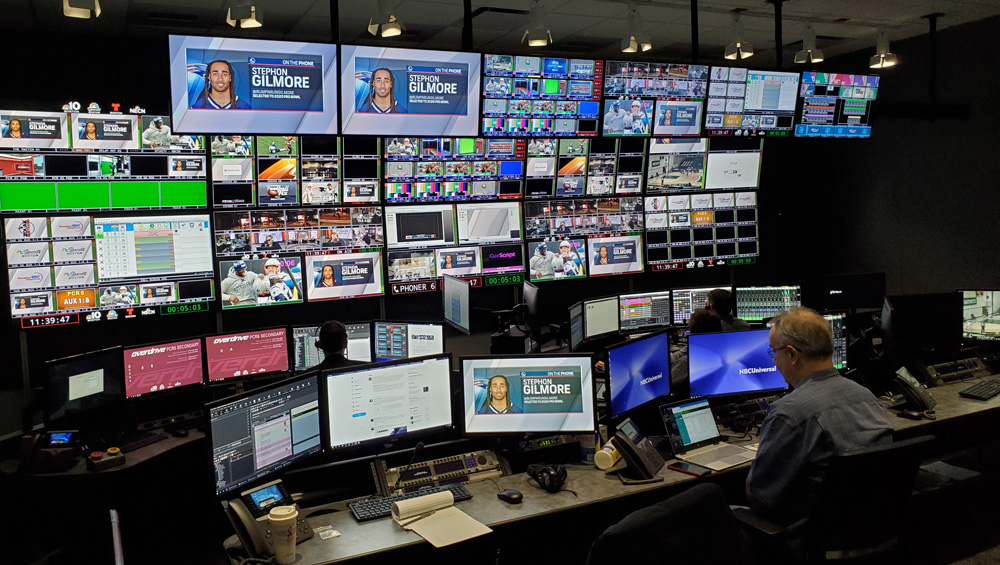
Scale Dictates Broadcasters’ IP Transition

The ability to route thousands of video signals, including uncompressed 4K UHD, has prompted major networks like CNN and the CBC and mobile truck vendors like Game Creek Video and All Mobile Video to invest in new IP routing systems based on the SMPTE 2110 standard. But the pace of adoption for 2110 has been much slower among local broadcasters.
There have been a few new IP builds by network O&O’s in major markets including NBC’s stations in Philadelphia and Boston and Fox’s WTTG in Washington, D.C. But most stations are choosing to ease into IP and prolong the life of their existing HD-SDI baseband routing systems as long as possible. Some are even buying brand-new HD-SDI gear when a routing refresh is required. That mindset is persisting even as many early interoperability problems have been solved and the price of IP equipment has come down.
A Matter Of Scale
Scale is the biggest factor in broadcasters’ decision-making, say technology vendors. While networks have the need to produce multiple program streams for various distribution outlets, small-to-mid-market stations may have only one major program stream they produce themselves — their local newscasts. And it is unclear when, or if, those newscasts will need to be produced in 4K with high dynamic range [HDR] to maintain stations’ competitive footing. So, the vast flexibility and high bandwidth of a 100-gigabit-per-second 2110 routing infrastructure may be more horsepower than they need.

John Mailhot
“In the local TV market, there are [more than 200] markets in the U.S., and they’re all different,” says John Mailhot, CTO of networking and infrastructure for Imagine Communications. “The big markets often do have the scale that it starts to make sense for IP. Even a year or two or three ago, you saw some early adopters there. As you move downmarket, the scale is very different.”
Mailhot says large station groups are currently evaluating what their “cookie cutter strategy” will be to convert their bigger stations to IP first. Then they’ll move that strategy downmarket.
That seems consistent with the approach to IP being taken by Hearst Television, which did a successful proof of concept (POC) last year and is currently doing pilot projects at WLWT Cincinnati and WESH Orlando, Fla. The goal is to identify who will be Hearst’s key technology partners going forward and to create a coherent technology plan to migrate stations to 2110.
“We are constantly working on how we roll this out,” Hearst VP of Engineering Stefan Hadl says.

Stefan Hadl
If Hearst was building a greenfield site, then going 2110 would be an easy decision, Hadl says. But the thought process is more nuanced when doing technology refreshes within existing HD-SDI plants.
“We know we have to take care of today but also be thinking about tomorrow,” Hadl says. “So, in some markets that may mean that some legacy purchases have to be made. But those purchases have to be very strategic and smart in the sense that they afford us the ability to easily do 2110.
“For example, if we have to replace a router, that router will have 2110 capability,” he adds. “It’s my gateway, and it’s the perfect place to start. To say, OK, here you go, here’s 32 IP sources, and let’s continue to move those around in the new world of 2110.”
Cost Concerns
Cost is often the most important consideration for station groups weighing an investment in 2110 versus buying new HD-SDI gear, says Jason Kornweiss, VP and GM of emerging technology & solutions for leading systems integrator Diversified. And that doesn’t just mean the initial capital investment — which is generally 30%-40% higher for 2110 — but the total cost of ownership (TCO) including training and ongoing operational costs.

Jason Kornweiss
“Many station groups, including big-market station groups, are realizing that their engineering team may not be up to the challenge of owning and running and managing an entire IT infrastructure for broadcast,” Kornweiss says. “The learning curve, and the investment required to allow those teams to transition to a new system, has a bit of a double cost. You have the cost of the infrastructure itself, and then you have the cost of training and acquiring new talent to allow you to actually keep that television station on the air. It has become daunting in some cases.”
When local engineering teams don’t have the necessary skill sets that sends a “ripple uphill” to the few corporate staffers who do, as they wind up spending a lot of time solving local issues. And hiring new engineers who understand both IT and broadcast is expensive.
“As a result, the TCO is going up, even as the equipment starts to normalize,” Kornweiss says. “There is all this operational expense that was unforeseen in the transition to the new technology.”
In that vein, Diversified is now offering a new level of support and software integration for customers that continues after new IP builds are done, as stations need more ongoing support than they did with HD-SDI.

Mo Goyal
Mo Goyal, senior director of international business development for Evertz, agrees that many smaller station groups are weighing the benefits of IP routing versus the learning curve their team will have to go through to manage the additional complexity. IP is an obvious first choice for a new facility where “you’re building things from scratch,” he says. But the answer isn’t as clear for an older facility in need of a technology refresh, particularly for a smaller station that doesn’t have very large-scale production needs.
“There is still that sort of balance,” Goyal says. “If you’re a small station and you’re not doing a full buildout, and you still have legacy equipment to maintain, you may be looking to continue on with aging SDI equipment as long as [you] can.”
Ironing Out Training
Many of the big challenges in early IP installations have been solved and the technology has greatly stabilized in the last two years, Mailhot says. He thinks concerns about stations having the technical expertise to manage 2110 may be a bit overblown and says that part of the process of installing any new technology in a facility is learning how to use it and maintain it.
“Early on the tools might have been a little rough, and there was some driver development and other things that happened that caused early projects to have a little bit of a science feel,” Mailhot says. “But at this point we roll out 2110 systems to customers about the same way and using basically the same people in the field that were installing routers three or four years ago. Our staff is retrained to know how to build and configure the IP systems, and customers learn how to understand and use the systems.”
Manufacturers are providing ways to make it easier for traditional broadcast engineers to work with 2110 technology. Adoption of the Advanced Media Workflow Association’s NMOS (Networked Media Open Specifications) protocol for communicating with and controlling remote equipment has been helpful in simplifying deployment. Key specs include IS-04, which handles device discovery and registration, and IS-05, which covers connection management.
Vendors of routing orchestration software have also come with visual displays that help engineers better understand where signals are going.
“The tools that we leave the customer with, it looks like a router, it smells like a router, it has control panels like a router, and it acts like a router,” Mailhot says. “And we support it and the way it integrates to their workflow is that it acts like a router.”
Evertz has created a new system called NATX that is designed to make configuring new routing destinations easier in an IP multicast network by having network address translation [NAT] built in.
“When switching, you have to tune the edge device to listen to something new,” Goyal explains. “The NATX fixes those addresses and does the translation anytime you route things to it.”
Once the network address is fixed for a new edge device, the NATX system remembers it and makes operation similar to an SDI router going forward, he says.
“The tools are really helping the industry to pick up IP without having to really know a lot,” Goyal says. “So instead of making a crosspoint switch, I’m subscribing to a multicast over here. That’s the part that helps.”
Supply Chain Snafus Switch Up The Market
Global supply chain issues stemming from the COVID-19 pandemic have also slowed 2110’s momentum, as prospective buyers now have to wait anywhere from six to 12 months to get IP switches from big networking vendors like Cisco and Arista. The turnaround time on HD-SDI gear has also been slowed by supply chain issues but is still roughly half the time of IP. That is prompting more customers to take a second look at HD-SDI, particularly in smaller markets.
“One of the biggest challenges right now is getting the switch gear,” Paulsen says. “It’s not less than six months in almost every case right now. So, there’s a real negative for anybody, for enthusiasm, right now. And there are other products there that can provide an alternative.”
Imagine’s Mailhot agrees that lead times for big IP projects have grown longer than SDI, though he says the smaller side of the IP market is faring better.
“If you’re looking for the big, giant chassis switches that you would use on a very large project, there is certainly a lead time challenge that is different than it used to be,” Mailhot says. “SDI is a very mature technology — everything about it is mature, the manufacturing is mature. We ship those as ordered, pretty much.”
Other routing vendors acknowledged delays in getting 2110 switching gear but say they face similar supply chain problems with their legacy HD-SDI products.

Neal Maycock
“Silicon problems are affecting our SDI products as well,” says Grass Valley CMO Neal Maycock. “Across the board, we see these problems. In certain circumstances, we’re seeing component lead times on standard video parts going out six to 12 months.”
Evertz has faced some supply chain issues and is actively working to prevent future shortages of key components. But the company is still able to meet deliveries and is actively deploying 2110 gear in several projects. Goyal doesn’t believe supply chain issues have impacted 2110 products any more than HD-SDI.
“They are all using some common parts,” Goyal says. “Most of the core technologies are FPGAs [Field Programmable Gate Arrays] that are common on multiple platforms and products around the world.”
Weighing The 4K Question
Evertz is still selling a “significant amount” of smaller-scale SDI routers in the 200×200 or 256×256 range, Goyal adds, including EQX and new NEXX models that both have 12-gig capability for 4K support. With the addition of IP gateway cards, these routers can also be used in conjunction with IP routers in the future in a hybrid architecture.
While 4K routing over SDI was previously handled in a quad-link configuration with four 3-gig signals being carried on separate cables, the newer routers can now support 12 gig on a single signal path, Goyal says. With an input/output card, those 12-gig streams can then be encapsulated as 2110 uncompressed and taken into an IP network.
They could also be compressed using JPEG-XS, which Goyal says is starting to become the “de facto codec” for UHD production. For 1080p at 3 gigabits per second, that gets the data rate into the 100-150 Mbps range, while 4K at 12 gigs is compressed to around 800 Mbs. But that strategy has its limits.
“For larger new builds, it’s strictly IP,” Goyal says. “There’s no discussion there. They’re not building facilities with large-scale SDI routers, like 1000×1000.”
Demand for 12-gig SDI is particularly strong in Asia, Goyal says, where there is more immediate emphasis on 4K production. The path to 4K for local U.S. broadcasters is less clear, as many networks see 1080p HDR as a good interim solution that can be supported by existing production and distribution chains. If the networks see 1080p HDR as being good enough for major sports coverage, then it’s unlikely that local stations will see a pressing need to produce their news and other local programming in 4K.
HD-SDI remains a cost-effective and very viable solution for local stations, Mailhot says, until they have to produce in 4K.
“That’s the variable everyone’s got to take their guess on,” Mailhot says. “To what extent will UHD [4K] happen as a side effect of ATSC 3.0, or will the predominant distribution be 1080p, and then it becomes UHD [4K] in the home? If we’re doing true UHD [4K HDR] all the way from the network to the affiliate to the home, that’s going to drive some very interesting spend pattern. That might be delayed if the in-between is to do 1080p [HDR] and do it really well.”
































Comments (0)